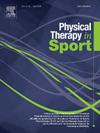People with patellofemoral pain have task-dependent postural control alterations
IF 2.2
3区 医学
Q1 REHABILITATION
引用次数: 0
Abstract
Objectives
To compare postural control between people with and without patellofemoral pain (PFP) during the Star Excursion Balance Test (SEBT), single-legged stance, single-legged squat, and single-legged landing tasks.
Design
Cross-sectional.
Settings
Laboratory.
Participants
Forty-four participants (22 with PFP and 22 controls).
Main outcomes measures
Postural control was evaluated by measuring reach distance in three directions during the SEBT, and center of pressure (CoP) behavior during the single-legged tasks.
Results
The PFP group demonstrated a larger CoP ellipse area during the single-legged squat (effect size [ES] = 0.82, p < 0.01) and landing tasks (ES = 0.70, p < 0.05) compared to controls. Additionally, the PFP group showed alterations in anteroposterior CoP behavior during the single-legged squat compared to controls, including increased displacement (ES = 0.78, p < 0.01), trajectory length (ES = 0.62, p < 0.05), and velocity (ES = 0.61, p < 0.03). No significant differences were found between groups for any distance in the SEBT or for CoP variables during the single-legged stance.
Conclusions
People with PFP exhibit postural control alterations during more dynamic tasks, such as single-legged squats and landings. However, no alteration during static tasks like single-leg stance or during any SEBT direction were observed.
髌骨痛患者有任务依赖型姿势控制改变
目的比较髌骨痛(PFP)患者和非PFP患者在进行星偏移平衡测试(SEBT)、单腿站立、单腿深蹲和单腿着地任务时的姿势控制情况。参与者:44名参与者(22名PFP患者和22名对照组)。主要结果测量:通过测量SEBT期间三个方向的到达距离和单腿任务期间的压力中心(CoP)行为来评估姿势控制。结果PFP组在单腿深蹲时CoP椭圆面积更大(效应量[ES] = 0.82, p <;0.01)和着陆任务(ES = 0.70, p <;0.05)。此外,与对照组相比,PFP组在单腿深蹲时的前后位CoP行为发生了变化,包括位移增加(ES = 0.78, p <;0.01),弹道长度(ES = 0.62, p <;0.05),速度(ES = 0.61, p <;0.03)。在单腿站立时,两组之间SEBT的任何距离或CoP变量均无显著差异。结论:PFP患者在进行动态动作时,如单腿深蹲和落地时,会出现姿势控制的改变。然而,在静态任务中,如单腿站立或在任何SEBT方向,没有观察到变化。
本文章由计算机程序翻译,如有差异,请以英文原文为准。
求助全文
约1分钟内获得全文
求助全文
来源期刊

Physical Therapy in Sport
医学-康复医学
CiteScore
4.50
自引率
8.30%
发文量
125
审稿时长
39 days
期刊介绍:
Physical Therapy in Sport is an international peer-reviewed journal that provides a forum for the publication of research and clinical practice material relevant to the healthcare professions involved in sports and exercise medicine, and rehabilitation. The journal publishes material that is indispensable for day-to-day practice and continuing professional development. Physical Therapy in Sport covers topics dealing with the diagnosis, treatment, and prevention of injuries, as well as more general areas of sports and exercise medicine and related sports science.
The journal publishes original research, case studies, reviews, masterclasses, papers on clinical approaches, and book reviews, as well as occasional reports from conferences. Papers are double-blind peer-reviewed by our international advisory board and other international experts, and submissions from a broad range of disciplines are actively encouraged.
 求助内容:
求助内容: 应助结果提醒方式:
应助结果提醒方式:


